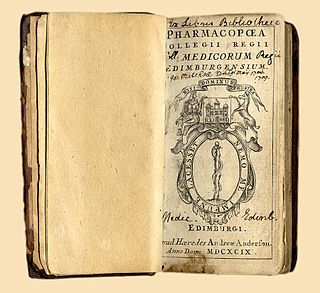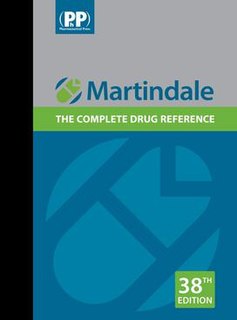
The British National Formulary (BNF) is a United Kingdom (UK) pharmaceutical reference book that contains a wide spectrum of information and advice on prescribing and pharmacology, along with specific facts and details about many medicines available on the UK National Health Service (NHS). Information within the BNF includes indication(s), contraindications, side effects, doses, legal classification, names and prices of available proprietary and generic formulations, and any other notable points. Though it is a national formulary, it nevertheless also includes entries for some medicines which are not available under the NHS, and must be prescribed and/or purchased privately. A symbol clearly denotes such drugs in their entry.

Fluphenazine, sold under the brand names Prolixin among others, is an antipsychotic medication. It is used in the treatment of chronic psychoses such as schizophrenia, and appears to be about equal in effectiveness to low-potency antipsychotics like chlorpromazine. It is given by mouth, injection into a muscle, or just under the skin. There is also a long acting injectable version that may last for up to four weeks. Fluphenazine decanoate, the depot injection form of fluphenazine, should not be used by people with severe depression.

A pharmacist, also known as a chemist or a druggist, is a health professional who knows the composition, properties, interactions and proper use of medications. At the same time, the pharmacist provides pharmaceutical information and advice to the public, as well as primary health care services. Using knowledge of the mechanism of action of drugs, the pharmacist understands how they should be used to achieve maximum benefit, minimal side effects and to avoid drug interactions. Pharmacists undergo university or graduate-level education to understand the biochemical mechanisms and actions of drugs, drug uses, therapeutic roles, side effects, potential drug interactions, and monitoring parameters. This is mated to anatomy, physiology, and pathophysiology. Pharmacists interpret and communicate this specialized knowledge to patients, physicians, and other health care providers.

Pharmacy is the clinical health science that links medical science with chemistry and it is charged with the discovery, production, disposal, safe and effective use, and control of medications and drugs. The practice of pharmacy requires excellent knowledge of drugs, their mechanism of action, side effects, interactions, mobility and toxicity. At the same time, it requires knowledge of treatment and understanding of the pathological process. Some specialties of pharmacists, such as that of clinical pharmacists, require other skills, e.g. knowledge about the acquisition and evaluation of physical and laboratory data.

A pharmacopoeia, pharmacopeia, or pharmacopoea, in its modern technical sense, is a book containing directions for the identification of compound medicines, and published by the authority of a government or a medical or pharmaceutical society.
The pregnancy category of a medication is an assessment of the risk of fetal injury due to the pharmaceutical, if it is used as directed by the mother during pregnancy. It does not include any risks conferred by pharmaceutical agents or their metabolites in breast milk.

Australian Medicines Handbook (AMH) is a peer-reviewed medicines prescribing guide for Australian health professionals. The handbook is available in paper and digital formats and is supplemented by the AMH Aged Care Companion and the AMH Children's Dosing Companion.
The Royal Pharmaceutical Society is the body responsible for the leadership and support of the pharmacy profession (pharmacists) within England, Scotland and Wales. It was created along with the General Pharmaceutical Council (GPhC) in September 2010 when the previous Royal Pharmaceutical Society of Great Britain was split so that representative and regulatory functions of the pharmacy profession could be separated. Although membership of the Society is not a prerequisite for engaging in practice as a pharmacist within the United Kingdom, most practising pharmacists opt to join the Society because of the benefits offered by membership. Its predecessor the Pharmaceutical Society of Great Britain was founded on 15 April 1841.

Prochlorperazine, formerly sold under the brand name Compazine among others, is a medication used to treat nausea, schizophrenia, migraines, and anxiety. It is a less preferred medication for anxiety. It may be taken by mouth, rectally, injection into a vein, or injection into a muscle.

Capecitabine, sold under the brand name Xeloda among others, is a chemotherapy medication used to treat breast cancer, gastric cancer and colorectal cancer. For breast cancer it is often used together with docetaxel. It is taken by mouth.
The British Pharmacopoeia (BP) is the national pharmacopoeia of the United Kingdom. It is an annually published collection of quality standards for UK medicinal substances, which is used by individuals and organisations involved in pharmaceutical research, development, manufacture and testing.

The British National Formulary for Children (BNFC) is the standard UK paediatric reference for prescribing and pharmacology.

Paliperidone, sold under the trade name Invega among others, is an atypical antipsychotic. It is mainly used to treat schizophrenia and schizoaffective disorder.

Martindale: The Complete Drug Reference is a reference book published by Pharmaceutical Press listing some 6,000 drugs and medicines used throughout the world, including details of over 180,000 proprietary preparations. It also includes almost 700 disease treatment reviews. It was first published in 1883 under the title Martindale: The Extra Pharmacopoeia. Martindale contains information on drugs in clinical use worldwide, as well as selected investigational and veterinary drugs, herbal and complementary medicines, pharmaceutical excipients, vitamins and nutritional agents, vaccines, radiopharmaceuticals, contrast media and diagnostic agents, medicinal gases, drugs of abuse and recreational drugs, toxic substances, disinfectants, and pesticides.
Pharmaceutical policy is a branch of health policy that deals with the development, provision and use of medications within a health care system. It embraces drugs, biologics, vaccines and natural health products. Pharmaceutical policy includes:
At its most basic level, a formulary is a list of medicines. Traditionally, a formulary contained a collection of formulas for the compounding and testing of medication. Today, the main function of a prescription formulary is to specify particular medications that are approved to be prescribed at a particular hospital, in a particular health system, or under a particular health insurance policy. The development of prescription formularies is based on evaluations of efficacy, safety, and cost-effectiveness of drugs.

Pharmaceutical Press is the publishing arm of the Royal Pharmaceutical Society. It is a provider of independent pharmaceutical information.
Drug nomenclature is the systematic naming of drugs, especially pharmaceutical drugs. In the majority of circumstances, drugs have 3 types of names: chemical names, the most important of which is the IUPAC name; generic or nonproprietary names, the most important of which are the International Nonproprietary Names (INNs); and trade names, which are brand names. Under the INN system, generic names for drugs are constructed out of affixes and stems that classify the drugs into useful categories while keeping related names distinguishable. A marketed drug might also have a company code or compound code.
EMDEX is the most commonly used reference source of drug and therapeutic information by healthcare professionals in Nigeria. It was first published in 1991 as Nigeria's Essential Drugs (NED) Guide.
EMDEX drug information contents, arrangements and therapeutic recommendations are supported by several references and clinical guidelines notably WHO Model Formulary, WHO ATC Classification System, Nigeria's Essential Medicines List and Standard Treatment Guidelines, etc. The information is regularly reviewed and updated by a select team of healthcare practitioners and academics.
The central objective of EMDEX has been to promote rational use of medicines through provision of independent drug information, and use of clinical guidelines and essential medicines list. It is the largest and up-to-date source of information on drug products approved for use in Nigeria by NAFDAC .
The use of EMDEX as a reference drug manual is endorsed by Pharmacists Council of Nigeria, Nursing & Midwifery Council of Nigeria and major health institutions. It is used both within and outside Nigeria by physicians, dentists, pharmacists, nurse practitioners, and auxiliary health workers at all levels of healthcare delivery. These healthcare providers rely on EMDEX for accuracy and completeness of drug information namely indications, contra-indications, precautions or warnings, adverse effects, dosages, and drug use in special populations like children, elderly, pregnancy & lactation.
EMDEX publications are also in the syllabus of various colleges & schools of medicine, pharmacy & nursing.











